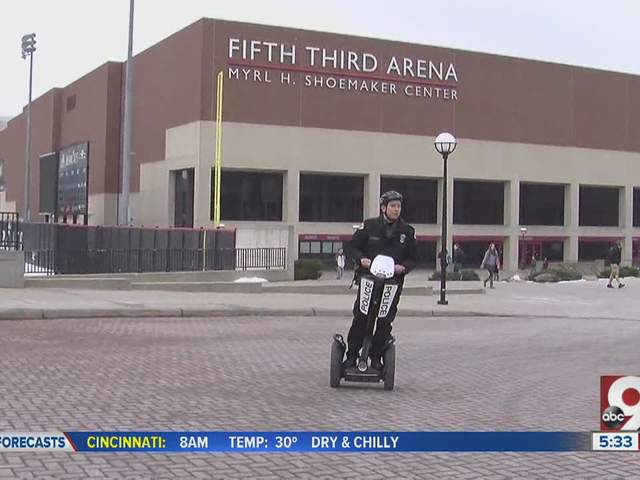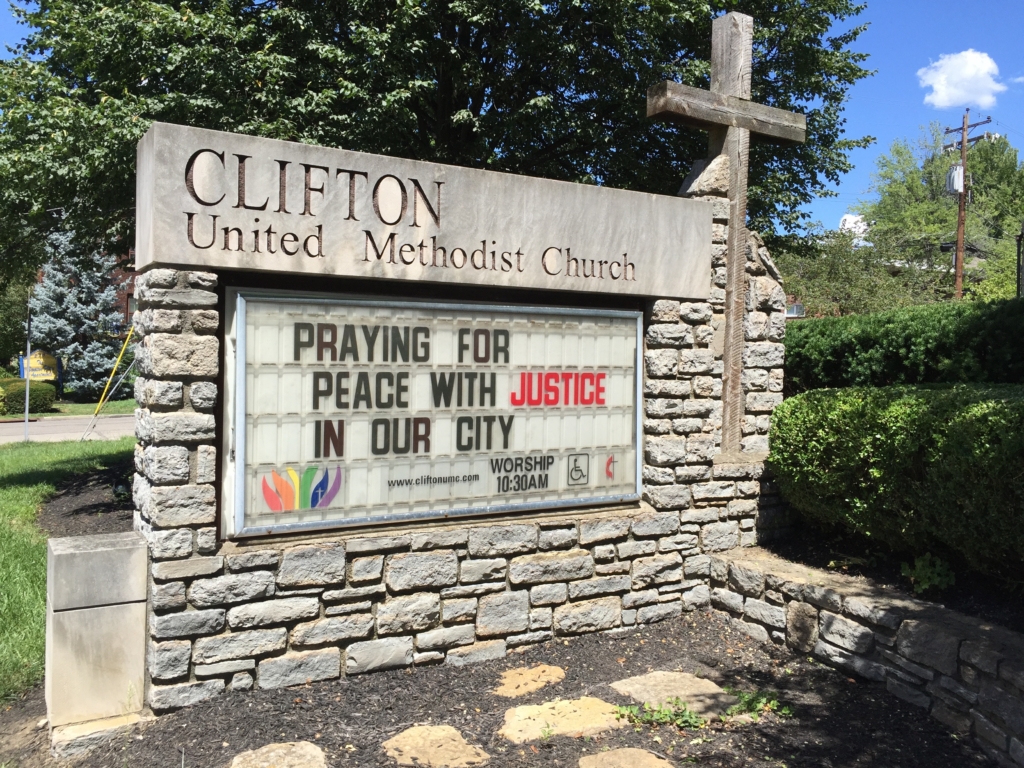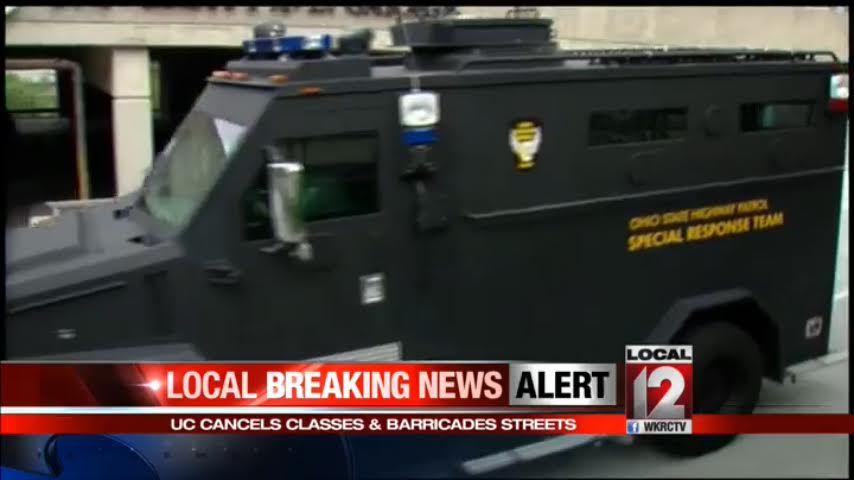
Eric Van Hoose is a doctoral student at the University of Cincinnati. He writes a monthly column for Full Stop about prisons and popular culture.
My car was parked on a quiet, tree-shaded street in the Clifton neighborhood of Cincinnati. I was going to drive to my job at a retail store inside a shopping mall, but the rear corner window had been smashed. A few small things — an old GPS unit, CDs, some change — were missing. A key (to what? I didn’t know) had been jammed into the ignition. The shattered glass — some on the concrete, some inside the dim car — looked bluer than I would have imagined it could.
That was five years ago.
I called the police to let them know what had happened. It felt like the right thing to do. I swept the glass shards out of my car seat. A man in a truck came and installed a new window, right there on the street, and I drove to work.
A few days later, I received a call. The Cincinnati police had arrested a suspect and retrieved some items. I could come to the station and pick them up, if I wanted. Nobody was sure which station was holding the things — the old, worthless GPS unit that I hadn’t used in years, the scratched CDs. The people I asked on the telephone were blunt, impatient. I was put on hold a lot. I was told I’d be called back, but I wasn’t. The police must have been busy.
It took a couple more days of calling before anyone could tell me for sure which station to visit. I’m not sure now why I was concerned, why I bothered to retrieve these items. Now it seems silly. But I drove to the police station and walked inside, where a woman in uniform sat behind a pane of bullet proof glass, and told her why I was there.
The only other time I’d been in a police station was when I was twelve or thirteen. As a boy, my life was consumed by skateboarding. I was often running from police. Hiding. I knew how they spoke to us, yelled at us. Even as a child I recognized their similarity to the bullies at my school. From the back of the cruiser, riding to the station, I listened to an officer’s monologue. “Yeah. I got picked on in school,” he said. “But now, those same people who used to give me a hard time? They’re the ones I’m arresting.” I saw his smile in the rearview mirror. His police work was his revenge. He drove with one hand, palm pressed against the wheel. He told this to me, to a boy who he’d arrested for skateboarding and for spray-painting a blue penis on the beige brick of a vacuum store.
I feared being caught by police, and I feared being taken to the station. I feared having the officer confiscate my skateboard or break it in front of me, as I’d seen happen to my friends. I didn’t fear being killed.
Plenty of people have never experienced a demeaning traffic stop. Not everyone sees, as part of their daily routine, the beautiful and simple hypocrisy of police gliding through red lights, rolling through stop signs, police who don’t obey the law.
***
Washington Park is a quick walk away from where Sam DuBose was shot and killed by Ray Tensing. There’s a dog park there, now. There are fountains where children play. It’s a short drive, directly south, from my apartment. In the summer of 2010, an officer drove his car off the road, through the park. He ran over a homeless woman who was sleeping there. The woman died. “She tried to get up, but then fell back down. She curled up in a ball and just rocked back and forth, moaning.”
Not everyone experiences the police as an occupying force, something like a terrorist group. A lot of people believe the police exist primarily to help them, to ensure their safety. But even these people might know, now, that police in the U.S. are murdering over a thousand people every year. (There are no official stats on this, of course, but The Guardian has been trying to keep track.) Even these people know the police might shoot the same people who have called them, who are in need and asking for help.
Police can be like ghosts. And plenty of police are not police at all: they are privately employed security, whose training is even less rigorous.
On July 19th Sam DuBose was pulled over by a University of Cincinnati police officer because his car did not have a front license plate. He was shot to death by the University of Cincinnati police officer Ray Tensing. In his statement announcing that Tensing would be charged with murder (a decision which was based largely on footage from Tensing’s body camera), Hamilton County Prosecutor Joe Deters said:
When I went to the Cincinnati police station to retrieve my GPS unit and my CDs, property worth maybe twenty dollars, there was a man in the waiting area. He had paperwork. He was speaking heatedly with an older officer, explaining that his car was going to be impounded, saying he had the papers they needed. He held the papers out for the officer to see, but the officer would not help him. He would not listen. “You’ll have to come back. The person you need to talk to isn’t here.” The man left the station frustrated. Walking through the door, he muttered, “Fuck this.” He was halfway to the parking lot when the officer stepped out after him and drew his gun. “What did you say?” The officer yelled. “You’d better keep walking.” My GPS and CDs were in a brown bag. I took them and left.
The University of Cincinnati police ride Segways.

Image via wcpo.com
Watching the televised news coverage of these murders, reading the headlines in the local and national papers, feels different when the most recent killing (until the next day, and the next one, and the next one) has happened five minutes from where you live. It’s different when the university shuts down in anticipation of protests and you don’t just read about it in the news, but also receive the same text message alert that the university sends to students and employees when there’s too much snow. It’s different when you see photographs of the military grade armored vehicles that were rolled onto campus and you recognize the buildings, the streets, because you’ve been in them, on them. Because you were planning on heading there later that afternoon. The university was not closed because anything was happening there, because anyone was there, readying to protest. It was closed preemptively, because after people saw the footage from officer Tensing’s body camera, which shows him shooting Sam DuBose in the head, people might have been there.
The University of Cincinnati will cancel all classes on the Uptown and Medical campuses at 11:00 a.m. today including all classes in session at that time. Offices on these campuses also will close at 11:00 a.m. This decision is made with an abundance of caution in anticipation of today’s announcement of the Hamilton County grand jury’s decision regarding the July 19 officer-involved shooting of Samuel Dubose and the release of the officer’s body camera video. We realize this is a challenging time for our university community.
In Kettering, Ohio, where police used to chase me through the streets for skateboarding, there’s now a skate park. It’s called the Rob Dyrdek/DC Shoes Skate Plaza. You can skate there as much as you want without being chased or arrested. The park is well designed. Its concrete is smooth. Most days, it’s full of skateboarders.
Ray Tensing was charged with murder. That doesn’t usually happen. In fact, it has never happened in Cincinnati before, despite dozens of police murders.
In 2001 people took to the streets in the historic Over the Rhine neighborhood, just north of downtown, just south of where DuBose was shot last month. It was, at the time, the largest so-called “riot” since Los Angeles in 1992.
People have donated less than $8,000 to an online fundraiser created for DuBose’s children. “A similar effort,” the Cincinnati Enquirer reports, “raised more than $200,000 for the family of a Cincinnati police officer gunned down by a suspect in June.”
Tensing’s bail was set at $1 million. “People from all over the country offered to help pay.” Tensing has bonded out of jail. He’s requesting his job back.
The video from Tensing’s body camera, which shows him shooting Sam DuBose in the head at close range, is available online. You don’t have to watch all the way to the end to hear Tensing’s voice. To watch his hands. People who complain about violent media say it desensitizes us, makes us less empathetic, more prone to violence.

Photo via Eric Van Hoose
A few weeks after I went to the police station to pick up my things, I was summoned to the trial of the man who broke into my car. I can’t remember his name; it happened in 2010. I went through the metal detectors and searched the enormous, gorgeous building to find the right courtroom. People sat shoulder to shoulder. People stood. There was not enough room. The man who had broken my car’s window and taken my GPS, my old CDs, my spare change — who I was seeing for the first time — stood before the judge. “You’re nineteen years old. You’ve been in and out of juvenile court since you were fourteen,” the judge said. She looked down at the man from her elevated platform, from the bench. “What’s with this fetish you have for cars?” She sentenced him to one year in jail. FREE A PIMP had been scrawled, in black marker, across the back of his striped uniform. I saw it when he turned to walked away, in handcuffs, guided by the bailiff through the courtroom’s wooden door.
This post may contain affiliate links.








